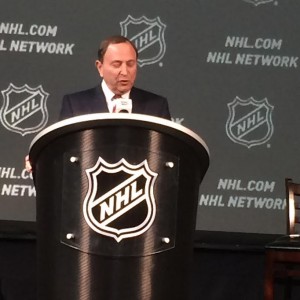Offside. A zany rule in the NHL that has become a moving target. Characterized by inconsistency in its application, the rule has served to influence the outcome of games and stir up frustration among fans.
Are the fans wrong? Is the rule being applied correctly? Also, there seems to be an element of subjectivity in making the call, and perhaps therein lies the root of frustration. Fans simply want consistency.
Offside by the Book
The 2015-16 Official NHL Rule Book defines offside as: “Players of the attacking team must not precede the puck into the attacking zone.” That certainly appears to be straightforward. But, there’s more.
Additionally, “The position of the player’s skates and not that of his stick shall be the determining factor in all instances in deciding an off-side. A player is off-side when both skates are completely over the leading edge of the blue line involved in the play.” So a player can wag his stick across the blue line as long as his skates are not beyond it. Gotcha. But, there’s more.

“A player is on-side when either of his skates are in contact with, or on his own side of the line, at the instant the puck completely crosses the leading edge of the blue line regardless of the position of his stick. However, a player actually controlling the puck who shall cross the line ahead of the puck shall not be considered “off-side,” provided he had possession and control of the puck prior to his skates crossing the blue line.” It’s really very simple. But, there’s more.
“It should be noted that while the position of the player’s skates is what determines whether a player is “off-side,” nevertheless the question of an “off-side” never arises until the puck has completely crossed the leading edge of the blue line at which time the decision is to be made.” So, it’s all about the skates (and the puck).
As I read the rule I keep waiting for it to also mention the position of the vendor guy selling beer in the front row of box seats, but maybe that will be in next year’s rule book. Seriously, despite the detailed explanation that seems to muddy the concept, it appears to actually be fairly straightforward. It’s the skates and nothing but the skates (and the puck).
What is the Problem?
Ask Carolina Hurricanes fans and they will tell you that there is a problem with the application of the rule. They will quickly point to their team’s recent game against the Washington Capitals, wherein there was a controversial non-offside call that resulted in a game-winning goal being scored by the Capitals’ Alex Ovechkin. In case you missed it, here is the play in question:
Capitals center Evgeny Kuznetsov was moving the puck forward and appeared to lose control, resulting in his skates crossing the blue line before the puck. Offside, right? Apparently Hurricanes head coach Bill Peters thought so and went to a coach’s challenge. The play was reviewed and the play was upheld, no offside, goal counts, game over, see ya. Oh and congratulations to the Capitals for clinching a playoff berth.
https://twitter.com/Piratesfanjoe/status/709915554602225664
That tricky paragraph in the rule that I cited earlier seemed to be the justification for the non-call. Kuznetsov had control of the puck, although seemed to lose it briefly, but not for long enough to make a difference in the minds of those that reviewed the play. That’s just fine, but not when compared to an earlier call by the same officials in the same game in an almost identical situation. (Oh, and Commissioner Bettman if you are reading this, having the officials explain their rulings would be a great help going forward).
Consistency Please

Hurricanes’ forward Jeff Skinner was flagged for being offside earlier in the game. With around 14 minutes left in the third period, Skinner was bringing the puck up the ice and it slipped off his stick and he crossed the line, regaining control after he crossed it. Skinner was called offside. Kuznetsov was ruled to be on-side.
To make matters worse for the fans of the Hurricanes, the NHL later admitted that Skinner should not have been called offside. On the Hurricanes’ website, Peters said of the Kuznetsov call:
“I think the NHL needs to educate the people in the league and the people that watch the league on what’s offside and what’s not offside. To them, that’s a legal entry. We understand the rule. They deemed he had possession. They deemed that’s quality possession, so it’s a good goal.”
Peters accepted the call, but also had some additional thoughts for the league.
“It would be nice if the league stepped up and educated people on that play so when it happens again in the playoffs in a real meaningful game, in an elimination game in overtime and that’s the game-winner, they don’t quite look as bad. They have a chance to get ahead of it right now, and we’ll see if they do.”
Peters is spot-on. The NHL needs to get a sense of consistency going on this rule, especially with the playoffs looming and huge outcomes at stake for the teams. As to the league admitting they erred on the Skinner call, Peters was very direct saying,
“So they threw the linesman under the bus on that one. That’s a bad call, but the other one’s a good call. They’re the same play, so we’ve got an issue.”
Again Peters is right, there is an issue and the league’s officiating powers that be need to fix it before it gets out of hand.
@NHLCanes Officiating gets worse when the league allows subjectivity into officials' decisionmaking process. @NHL needs to delete that rule.
— Dean Plunkett (@DeanPlunkettTHW) March 16, 2016
The subjective nature of calling offside or not, based on a subjective view of whether or not a player “possesses the puck” is a problem that may not have a viable solution. Whether or not deleting the rule or changing it is the answer is not for me to say. I do agree with Peters that consistency would be nice.
The issue of what constitutes puck possession as it relates to offside is not easy to define 100 percent of the time. It’s a fast game with humans making split-second calls on the ice. However, having the help of video review to slow the action down and either confirm or overturn decisions should help make this call more consistent. Just not for the ‘Canes versus the Capitals.